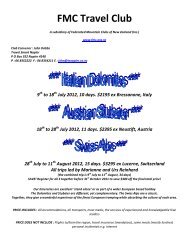August 2012 Issue - Federated Mountain Clubs of NZ
August 2012 Issue - Federated Mountain Clubs of NZ
August 2012 Issue - Federated Mountain Clubs of NZ
You also want an ePaper? Increase the reach of your titles
YUMPU automatically turns print PDFs into web optimized ePapers that Google loves.
ReviewsFocus on William Colensoby Shaun BarnettIn the last two years William Colenso has madean extraordinary comeback, with four newbooks featuring his life or work as their subjects,as well as a major conference in Napier.Printer, missionary, explorer, naturalist andpolitician, the nineteenth century Cornishmanwho helped found Napier was a fascinatingcharacter by any measure. Trampers know himbest for his travels over the Ruahine Range,and through the bush country <strong>of</strong> Te Urewera.Colenso’s eight crossings <strong>of</strong> the Ruahine Range,including the first by a Pakeha, marked him outas an explorer, and on these journeys he was alsothe first to collect alpine plants from the area.Colenso became a prodigious footslogger, not justbecause he loathed sea travel, but also becausehe enjoyed walking. Indeed, he can arguably becalled New Zealand’s first tramper.Colenso can also be regarded as the father<strong>of</strong> New Zealand printing (although strictlyspeakinghe was not the country’s first printer).After leaving Cornwall, aged in his early twenties,he arrived in New Zealand in 1834 to work asa printer with the Church Missionary Society.Not only was Colenso present at the signing <strong>of</strong>the Treaty <strong>of</strong> Waitangi in 1840, but he printedthe Maori version <strong>of</strong> it. By then fluent in TeReo, Colenso wanted to became a missionary,and eventually had his wish granted when in1844 the CMS posted him to Hawke’s Bay asa deacon in order to establish a mission stationat Waitangi, near present-day Napier. It wasfrom here that Colenso launched himself intothe Ruahines, using a long-unused Maori trailacross the ranges.But in 1852 Colenso fell from grace afterit became known that he had fathered anillegitimate child with a Maori woman, RipekaMeretene, who was part <strong>of</strong> the household staffat Waitangi. Expelled from the church, despisedby many <strong>of</strong> his former allies and friends, Colensonevertheless continued to stay in Hawke’sBay, and reinvented himself as a land-owner,naturalist, collector, school inspector and –briefly – politician. Overbearing, difficult andoutspoken are some words to describe hischaracter, but generous, whole-hearted andmisunderstood are others. In many ways he wasa man far ahead <strong>of</strong> his time – notably in his viewthat Maori should not sell their land, for which hewas disliked by both land-hungry Pakeha settlersand those Maori wishing to pr<strong>of</strong>it from sales.Last November, the Hawke’s Bay Museumand Art Gallery hosted a major conferenceon Colenso, marking the 200th aniversary <strong>of</strong>his birth. About 100 people attended, withpresentations covering all aspects <strong>of</strong> his life andwork. The conference also coincided with thelaunch <strong>of</strong> Peter Wells’s ambitious new biography<strong>of</strong> Colenso, The Hungry Heart, and two morevolumes featuring Colenso’s work – one onhis collections, and the other on his letters tothe editor, both edited by Colenso-phile IanSt George. St George is also about to releasea new edition <strong>of</strong> the classic 1948 biography<strong>of</strong> Colenso by A. Bagnall and G. Petersen.Colenso would no doubt be delighted by allthis attention. Complex, spirited and energetic,Colenso excelled in so many aspects <strong>of</strong> life, andlived for so long (he died in 1899, aged 88), thathis life and writings form important parts <strong>of</strong> ourcolonial – and indeed tramping – history.52FMC Bulletin • <strong>August</strong> <strong>2012</strong>






